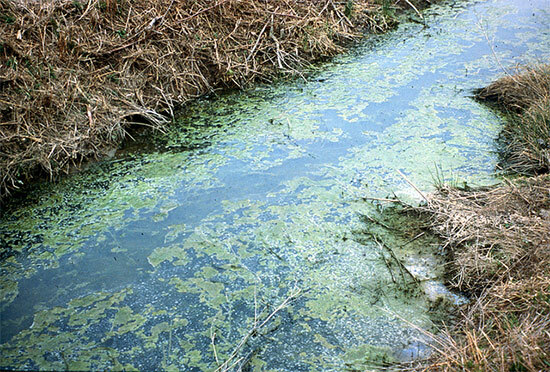It sounds like something out of a disaster movie – a metropolitan area of 500,000 people is left with toxic drinking water from an out-of-control act of nature spurred by industrial waste.
It sounds like something out of a disaster movie – a metropolitan area of 500,000 people is left with toxic drinking water from an out-of-control act of nature spurred by industrial waste. But that’s exactly what happened in Toledo, OH, this past weekend after a massive algae bloom exploded and poisoned the riverside town’s water supply.
So could a similar disaster happen here in RVA? The very short answer is not in the same way, said Chris Moore, senior scientist for Hampton Roads office of the Chesapeake Bay Foundation, a group which monitors the health of the bay and has a long history studying algae blooms.
Toledo draws its entire water supply from nearby Lake Erie, one of the
smallest of the Great Lakes. Lake Erie has often had algal blooms, and when
cyanobacteria
are exposed to immense heat and sunlight and overtake large bodies of
water.
Cyanobacteria are present in many aquatic bodies, including the Chesapeake Bay, but adding runoff from man-made enterprises like industrial farms (from nitrogen and phosphorus fertilizers) can lead to exponential reproduction of the bacteria.
Known as eutrophication, this excess supply of nutrients in the water allows fast-growing cyanobacteria to take over, suck oxygen out of the water, and leave harsh toxins in their wake.

The problem became particularly rampant in the 1960s and ‘70s before the passage of the Clean Water Act, though it has resurged in recent years with more toxic bacteria.
The cyanobacteria variety which has taken over Lake Erie this summer produces a toxin known as microcystin, which causes liver damage in humans. This bacteria is also found in the Chesapeake Bay, said Moore.
But because Virginia draws its water from sources upstream, there’s little risk of toxic drinking water like what happened in Toledo.
“But we’re seeing the exact same issues here that they’re seeing in Toledo in terms of eutrophication,” Moore said.
Because of the changes to the landscape of the Eastern Shore since the 1600s, the runoff of nitrogen, phosphorus, and sediment into the Chesapeake Bay has reached critical levels, according to the Chesapeake Bay Foundation.
The majority of the nitrogen and phosphorus runoff has been caused by agriculture – crops and chicken farms, which has also contributed to Lake Erie’s algal blooms. The Chesapeake Bay Foundation has focused on working with farmers and ranchers in the bay watershed to help reduce the runoff of fertilizer and animal waste.
The sediment runoff largely comes from the destruction of forest cover which usually prevents erosion in the watershed and wetlands along the shore, filtering out excess pollutants.
The excess nutrients reaching the Bay feed spreading algal blooms, which along with the light-blocking sediments have turned as much as one-third of the Bay into a “dead zone” during certain seasons.

These dead zones are areas where light is blocked from reaching the Bay floor, thus killing underwater grasses and causing the levels of dissolved oxygen in the water to drop. This makes the area uninhabitable by nearly all species of fish and crustaceans, causing massive fish kills and straining the local economy.
But polluted runoff is not just making the Bay dangerous for animals and plants. A 2008
study by Peter Tango, the Chesapeake watershed monitoring coordinator for the United States Geological Survey, found 31 percent of cyanobacterial blooms tested were toxic enough to be unsafe for children to swim in. “As long as eutrophic symptoms (high nutrient levels, low oxygen) continue in the Chesapeake Bay,” Tango wrote, “the persistence of cyanobacteria blooms will remain a signature indicator of impaired health.”
“There are lots of things that still need to be done,” Moore said of the health of the Chesapeake Bay. “But we have seen progress in bay restoration efforts. To learn more about the efforts to clean and restore the Chesapeake Bay, check out the Chesapeake Bay Clean Water Blueprint.



